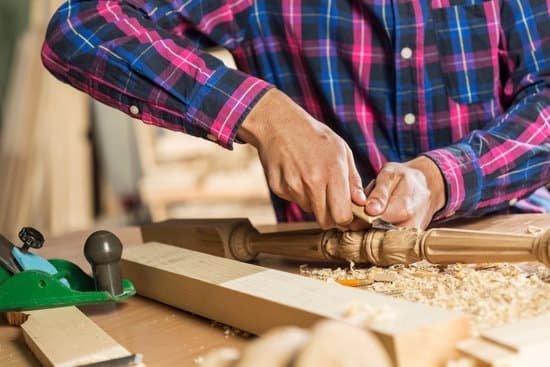Introduction
When it comes to woodworking projects, one of the most versatile and popular shapes to create is a large circle. This shape can not only be used as a decorative element on furniture pieces or structural supports in woodwork but can also be used as an architectural feature in areas such as round tables, countertops, and even arcades in bars or restaurants. A large circle can provide unique aesthetic appeal, allowing artists and woodworkers to be creative with their designs. Building a large circle out of wood is an art form that requires patience and skill, but offers great rewards when you achieve the finished product.
To draw a large circle for a woodworking project there are several items that are needed: a compass with adjustable legs, straightedge ruler, clamps to hold the drawing instruments together, circular saw and jigsaw. Before getting started, measure the desired diameter of the circle; this will allow for proper sizing of all your materials accordingly. Using your Ruler and Compass trace out lines which will serve as guideline for cutting out the shape of your circle from the board material you plan on using for your project. Once traced and planned correctly use your Circular Saw or Jigsaw to cut and shape the piece into your desired large circular shape. Secure with Clamps so that no movement of any kind occurs while cutting if necessary due to sizes or other factors. Finally use sandpaper or other tools to further refine edges until desired smoothness is reached before applying any finishes or sealing coats of choice.
Outlining Your Project
Choosing the Right Size Circle: The size of your circle will be determined by your overall project, the material you are working with, and the tools that you have. Generally, smaller circles can be drawn freehand and larger circles must be trace-drawn. This means that in order to draw a large circle woodworking project, you’ll need to decide on a size before selecting the necessary tools.
Essential Tools: Depending on what kind of woodworking project you’re undertaking, some basic tools required to draw a large circle might include a pencil to draw the outline of your circle; an accurate ruler or measuring tape; an adjustable square or compass set; a saw for cutting along circles outlines; chisels and gouges for detailing carved elements; sandpaper and sander for smoothing out the edges; and protective goggles for safety.
Tips for Drawing a Perfect Circle: To ensure accuracy when drawing your large circle, it is important that all angles remain perfectly square throughout the process. Create partials lines or points from which to initiate drawing with using an adjustable square or other tool. You should also make sure that as many points as possible rest within in the same plane or line to maintain uniformity – otherwise known as ‘trueing’. Lastly, when it comes time for cutting with saws or chisels, go slow and follow each cut carefully since it cannot be undone easily!
Different Wood Variations
Hardwoods are the best woods to use for large circle woodworking projects. Hardwoods, such as birch and maple, are strong, durable, and resistant to warping or splitting. Mahogany, cherry, and walnut are also ideal woods for large circles since they have a tight grain structure which makes them highly stable even when cut into large shapes. Hardwoods tend to be more expensive than softwoods. The best hardwood species for larger circles would be oak or ash.
Softwoods like pine, spruce, and cedar can also be used but should not be used if the large circle is going to be exposed to harsher weather conditions where moisture is present. Softwood circles can become bowed or warped in this type of environment. Softwoods may also be more prone to cracking along the inner diameter due to their lower density.
Bamboo can be a good choice for large circles as it is dense and stiff yet lightweight allowing it to bend slightly without breaking or cracking during installation process. Bamboo comes in different varieties so check with the supplier regarding what species will suit the intended usage best before making a purchase.
Preparing the Wood
Before beginning to draw a large circle in woodworking, it is crucial to prepare the work space. Start by clearing the area of all debris and other objects that could prevent any tools from gliding across with ease. Setting the workbench on a flat surface can also help maintain accuracy, as well as allow for stability when carving out the area. It is also beneficial to put down painter’s tape or even use magnets to adhere templates along the block of wood you will be working on; this helps in keeping items securely in one place and also allows for easy visualization of where the wood must be cut without having to move items around. Furthermore, taking measurements before starting to carve can provide extra detail and result in an accurate outline for your wooden circle. Utilizing a square ruler should help determine an exact angle for slicing off any excess material at the end. Lastly, laying out clamps onto both sides of the center should eliminate any sliding around or shifting while using tools for the project. For maximum concentration and success, having a good workspace setup is essential when woodworking on large circles.
Designing the Shape
If you are looking to draw a large circle for woodworking, the first step is to consider the desired shape. Depending on your project, a perfect circle may be what’s called for. There are several tracing and plotting methods that can help ensure that you create a perfect large circle pattern for use in woodworking projects.
One of the simplest ways to create a perfect circle is by using a compass and string. Tie one end of a length of string around a pencil or other object, leaving enough slack in the string to create an arc of the desired size if pulled taut. Use the compass tool to hold the string down while tracing it along the circumference of the intended shape. Once you have completed tracing one quarter of the outer edge, simply reposition into each 90 degree section until you have finished outlining all four quadrants evenly to achieve your ideal shape. This method is favored for its ease and affordability in comparison with other tools available for creating circles and shapes.
Another option includes using prisms or template guides ” these specialty tools provide jigs and curves cut from hard plastic which can easily act as both straight and curved lines when properly set up near your work piece . Measure out each side measurement before laying out grids with each section having corresponding exact degrees allowing multiple pieces to be joined together seamlessly creating any number shapes including circles needed For various projects requiring more precision cutting than free hand tools allow such as tablesaw cuts or biscuit blends, this method eliminates any variation between pieces ripped by power tools possible bridgeable gap sizes between them before post-fitting after glue up phase rather accurately giving more even results overall.. These are relatively inexpensive compared to some other design covering software options but still offer precision in larger scale designs that require accuracy over volume.
No matter what method you choose, planning ahead will go a long way towards ensuring that your project comes out just as expected!
Constructing the Pieces
The first step in creating a large circle is to construct individual pieces to use as building blocks. You will need a saw, such as a circular saw or jigsaw, to cut the pieces of wood that you’ll use for this project. Measure the length and width of your desired circle, then mark and cut each piece of wood accordingly. Discard any waste wood for a clean, uniform look. When cuts are finished, give yourself plenty of room to work by laying out your pieces on the floor or another flat surface.
Assembling the pieces can be done with several methods and depends on what type of material you used for your drawings’ construction; nails, glue, dowels or screws are all acceptable connections for secured tightening. Careful attention should be paid when aligning the shapes together; small misalignments here can create issues later in the process! Additionally, if working with metal rods, be sure to use appropriate connectors like threaded nuts and bolts rather than nails. Finally, complete assembly by gluing joints securely together so they stay tightly bound during further sanding and painting processes.
Sanding and Finishing
Once you have the shape of your large circle woodworking piece outlined, it is necessary to sand and finish it in order to give it a professional and attractive look. Sanding is the process of removing minor blemishes and leveling the surface of your circle so that all edges are smooth to the touch. Sanding can be a long process, depending on how precise you want your piece to be; however, it is important not to rush this step or your final product will suffer. There are a few techniques that you can use while sanding:
1. Start with a low grit sandpaper such as 120 grit and work up to finer grits like 220 or even 400. This approach ensures that there will not be any deep scratches remaining on your piece afterwards.
2. Use a small block sander for tougher areas of the piece. This type of sander can reach into more difficult curves and angles ensuring an even finish throughout the whole piece.
3. Lightly dampen the surface before sanding with either water or mineral oil if desired, as this will help reduce dust created by sanding and make sure all surfaces are level when finished.
4. Move in circles instead of sweeping back and forth from one direction as this will be more efficient when working on large pieces such as a circle woodwork project.
Once you have completed the sanding process, finishing your woodworking project is relatively straightforward but very important if want your product to remain attractive over time; otherwise, exposure to environmental elements such as moisture or extreme temperatures can cause damage to your workpiece, resulting in having to refinish sooner rather than later. Depending on how much protection you need, some popular finishes for woodworking include lacquer, shellac, tung oil, lacquer sealer and wax sealer – all providing various degrees of durability depending on what type of application they are used for; so it’s best worth doing some research beforehand before deciding which finish would suit best for your particular project best!
Conclusion
To draw a large circle woodworking, begin by using measuring devices to locate the center of the circle. Next, attach a string or cord to a nail or another securing object and adjust the loop with your hands until it is the size you want your circle to be. Hammer or drill two small holes where you want your circle edges to meet. Finally, secure the one end of the rope or string in one hole and guide your pencil along the length of the string for a perfect circle! Additionally, when working with larger circles it is important to take measure twice before cutting once as there may be additional cuts necessary due to varying lumber thicknesses. It is also often necessary to use clamps and weights to hold large boards in place while machining. Taking time up front to ensure accuracy and stability will result in high quality results that are sure to last for many years to come.

Hi everyone! I’m a woodworker and blogger, and this is my woodworking blog. In my blog, I share tips and tricks for woodworkers of all skill levels, as well as project ideas that you can try yourself.





